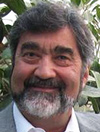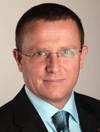Special talk
Prof. Rafael Marti (biography)
Department of Statistics and Operations Research, University of Valencia, Spain
 Black-box solvers in combinatorial optimization
Black-box solvers in combinatorial optimization
Black box optimizers have a long tradition in the field of operations research. These procedures treat the objective function evaluation as a black box and therefore do not take advantage of its specific structure. Black-box optimization refers to the process in which there is a complete separation between the evaluation of the objective function —and perhaps other functions used to enforce constraints— and the solution procedure. The challenge of optimizing black boxes is to develop methods that can produce outcomes of reasonable quality without taking advantage of problem structure and employing a computational effort that is adequate for the context.
Holland’s (1975) genetic algorithms proposal was in fact a black-box optimizer that used an array of bits as the generic representation. The proposed procedure did not include local search and the standard genetic operators (such as single-point crossover) were not linked to the problem context. As GAs became more popular and researchers and practitioner applied them to many hard optimization problems, the context-independent nature of the original proposal began to vanish when improved outcomes were obtained by the addition of problem structure. Hence, most modern GA implementations are hybridized (e.g., coupled with local searches) and incorporate domain-specific knowledge into the search process.
The black-box optimization framework is the OR (operations research) community response to the need for modeling flexibility and the separation between the modeling environment and the solution method. Achievements and progress in the solution of mathematical models of various types, including integer programs, are numerous and well-documented in the OR literature. Nonetheless, casting a problem as a mathematical model (integer or continuous, linear or nonlinear, or mixed) remains an exercise of imagination, abstraction and compromises.
During the last years we worked on the adaptation of metaheuristic methodologies to deal with combinatorial optimization problems. In order to treat them with a black-box tool, we classified these problems according to their solution representation: permutation, binary, and integer. In this talk we will review commercial black-box solvers, such as Opttek’s OptQuest, Palisade’s Evolver and Frontline’s Premium Solver, and compare their performance with our metaheuristic implementations based on the Scatter Search methodology on many different optimization problems.
Prof. Teodor Gabriel Crainic (biography)
Université du Québec à Montréal and CIRRELT - The Interuniversity Research Centre on Enterprise Networks, Logistics and Transportation, Canada
 Service Network Design for Intermodal Freight Transportation
Service Network Design for Intermodal Freight Transportation
Multi and intermodal freight transportation refers to moving loads by a sequence of transportation modes linked by mode-to-mode transfers performed at intermodal terminals, generally without directly handling the goods. Such transportation systems and the carriers that provide the associated services are often organized according to consolidation principles. Consolidation of the shipments of different shippers into the same vehicles and of several vehicles into blocks (railroads) and convoys (rail, road and barge trains).
Intermodal transportation is a core activity enabling global trade and supporting economic growth and social development. It is also also a mean toward more efficient and sustainable supply chains and transportation networks, within the city as well as for long-haul intercity exchanges. Achieving these goals requires the planning and management of efficient and timely transportation and terminal services, as well as of the resources required to provide these services. Operations research offers the modelling frameworks and solution methods to build these advanced planning methods.
In this presentation, we discuss the complex issue of designing the tactical transportation plan for intermodal carriers, that is, to select the services that will be operated over the next activity season, their schedules and the associated transportation itineraries for the forecast demand. We focus on recent developments to enrich the scope of the planning activities and associated models, by integrating a number of operational issues.
On the supply side, we examine the integration of the management of the resources required to provide the selected services while, on the demand side, we touch on the issue of the management of revenues.
Special talk
Prof. Coucke (biography)
 The endless journey to excellence can be structured with the EFQM model in the health care sector
The endless journey to excellence can be structured with the EFQM model in the health care sector
Management of quality and safety (MQS) in the industrial systems is a cornerstone of high reliability organizations (HRO’s). These HRO’s are relentlessly coping with a high intrinsic risk, do function with success and achieve high performance levels and handle the safety issue systematically and systemically.
In the Health Care Sector (HCS), there is at the start resistance to consider it as an “industrial system” although it responds to all the basic characteristic of the “system” as defined by von Bertalanffy. This cultural particularism is one of the major reasons for the “pandemic” outbreak of iatrogenic accidents (i.e. induced by the system failures). In 2013, John James from Patient Safety America, report at least 400’000 death yearly in the hospital sector in the USA which are due to system failures. What basically differentiates industrial HRO’S from the HCS is the integrated quality management (IQM). IQM is according to the National Association of Healthcare Quality, a planned, systematic approach to the monitoring, analysis, and correction and improvement of performance, which increases the likelihood of desired outcomes by continuously improving the quality of care and services provided.
All too often, the workers in the HCS are with their nose in the grindstone and do claim they have “no time or money” to dedicate to what does not seem priority. Moreover, as they do not accumulate data on the performance of the system they do lack situational awareness.
In 2008, the radiotherapy service at CHU-Liège, decided to be trained by safety officers issued from civil aviation in methodologies to improve safety and operational performance. To structure the long way to excellence, the generic model of the European Foundation for Quality Management was adopted. To motivate the “ecosystem” to adopt this for the HCS unnatural approach, the leader decided in 2009 to participate to the regional contest in Wallonia taking place every 2 years (MWQ = Mouvement Wallon pour la Qualité, based on the EFQM-model). The basic advantage of this “transversal” benchmark, is rapidly gaining expertise and knowledge from other sectors. In 2015, the last level of the four at MWQ is underway and the department did obtain the first prize at level one, two and three.
This is a hard time for leadership as in the HCS there are 5 very resistant myths of medical infallibility: medicine is something “special” and cannot be compared to industry, MD’s are totally free in a well-known and mastered environment, extensive theoretical knowledge is an excellent safeguard against error, hierarchical structure is an excellent safeguard against error, SOP’s and standards restrain MD’s in using their professional skill. Because of the observed pandemics and its enormous economic burden on society, it is high time to provoke a cultural earthquake in the HCS and to embrace at large IQM
